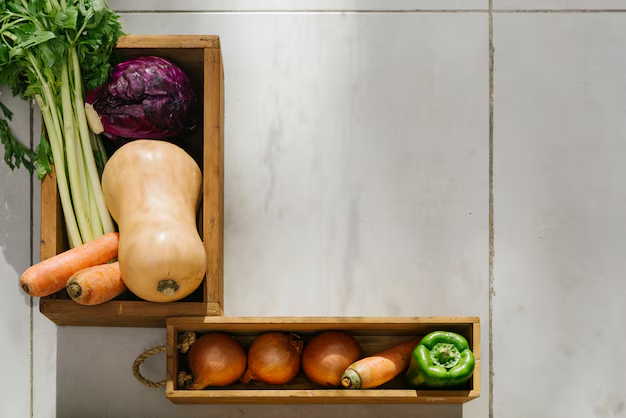How Long Can You Keep Cauliflower Fresh in the Fridge? 🥦
Cauliflower, a versatile and nutritious vegetable, has secured its place in kitchens around the world. Whether you're whipping up a creamy soup, a savory stir-fry, or a low-carb alternative to rice, cauliflower is a staple that deserves a spot in your meal planning. But when it comes to storing cauliflower, how long does it last in the refrigerator, and what are the best practices to ensure it stays fresh for as long as possible? In this guide, we'll explore the ins and outs of cauliflower storage, providing you with everything you need to know so your favorite veggie stays crisp and delicious.
Understanding Cauliflower's Shelf Life in the Fridge
The Average Lifespan of Refrigerated Cauliflower
Fresh cauliflower typically lasts in the refrigerator for about 1 to 2 weeks. This timeframe can vary based on a few factors, such as the initial freshness of the cauliflower at purchase and the storage method you employ. Keeping cauliflower fresh involves monitoring for signs of spoilage and understanding how its environment affects longevity.
Key Factors Influencing Cauliflower Freshness
Several elements come into play when determining how long cauliflower stays fresh in your fridge:
- Temperature: A consistently cool refrigerator temperature, ideally around 32-40°F (0-4°C), helps maintain freshness.
- Humidity: Cauliflower thrives in a humid environment; keeping it adequately moist can prevent wilting without encouraging mold.
- Airflow: Storing cauliflower in a breathable bag or a slightly open container allows fresh air to circulate, enhancing its shelf life.
Best Practices for Storing Cauliflower
Prepping Cauliflower for Optimal Storage
- Inspect Before Buying: Look for heads that are creamy-white, compact, and free of blemishes or soft spots.
- Skip Washing Before Storage: Washing can introduce unwanted moisture, leading to sogginess. Instead, rinse before using.
- Remove the Leaves: Trim any excess leaves and excess stem to save space and reduce the chance of decay.
Proper Storage Methods
- Loose Storage: Simply placing cauliflower in the fridge without any additional covering can expose it to refrigerator gases. It’s generally better to store it in a perforated plastic bag or wrapping it loosely with a damp paper towel.
- Use of Crisper Drawer: The crisper drawer offers an optimal environment with controlled humidity, helping your cauliflower last longer.
Signs of Spoilage
Be on the lookout for these indicators that your cauliflower may have outlived its freshness:
- Discoloration: Yellow or brown spots usually mean it's time to cook the cauliflower quickly or toss it.
- Odor: A strong, unpleasant smell is a clear sign that cauliflower is past its prime.
- Texture Changes: Soft, slimy, or mushy spots signal decay.
Exploring Cauliflower's Nutritional Benefits
Beyond its culinary versatility, cauliflower is packed with nutrition that supports overall health:
- Vitamins and Minerals: Rich in vitamin C, vitamin K, and folate.
- Fiber Content: High in dietary fiber, promoting good digestion and satiety.
- Antioxidants: Contains glucosinolates and isothiocyanates, compounds that have been studied for their potential health benefits.
Creative Uses for Cauliflower Beyond Raw Consumption
If you find cauliflower nearing the end of its shelf life, don’t throw it out! Instead, try incorporating it into:
- Purees or Soups: Create a creamy soup or mash similar to mashed potatoes.
- Cauliflower Rice: Riced cauliflower can be a great low-carb substitute for traditional grains.
- Pickling: Transform your cauliflower with some vinegar, spices, and a bit of time.
Frequently Asked Questions About Cauliflower Storage
Can You Freeze Cauliflower for Longer Storage?
Yes, freezing cauliflower is an excellent way to extend its shelf life. Here’s how to do it:
- Blanching: Briefly boil the cauliflower and then plunge it into ice water. This process preserves nutrients and color.
- Flash Freeze: Spread florets on a baking sheet, freeze until solid, then transfer to airtight containers or bags.
How Can You Tell if Cauliflower is Fresh at Purchase?
When shopping for cauliflower, freshness can be determined by its firmness, color, and overall appearance. Always choose dense heads with tightly packed florets and crisp, vibrant leaves.
Summary of Key Tips for Cauliflower Storage 📝
Here’s a quick recap of how to maximize the freshness of cauliflower:
- 🥦 Store in a cool, humid environment using the crisper drawer.
- 🥦 Avoid washing it before storage to prevent excess moisture.
- 🥦 Look for spoilage signs like spots and odors to avoid consumption.
- 🥦 Freeze or repurpose soon if cauliflower approaches its shelf-life limit.
By keeping these tips in mind, you'll ensure your cauliflower remains a fresh, delicious part of your meals while minimizing waste.
In conclusion, understanding the nuances of storing cauliflower not only helps preserve its taste and texture but also maximizes its nutritional benefits. Armed with this knowledge, you'll be able to enjoy this versatile vegetable to its fullest, all while keeping your kitchen running smoothly and efficiently.
